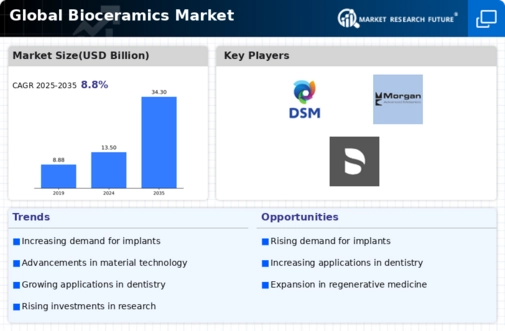Market Trends
Key Emerging Trends in the Bioceramics Market
The bioceramics market is experiencing notable trends that underscore its growth and evolving dynamics. Bioceramics, a specialized branch of ceramic materials designed for medical and healthcare applications, have witnessed increased traction in recent years. One prominent trend shaping the market is the escalating demand for orthopedic implants. As the global population ages, there is a corresponding rise in musculoskeletal disorders, leading to a surge in the need for bioceramic implants. These substances provide biocompatibility, longevity, and an excellent mechanical response, thus being suitable for situations like replaceable joints and implants for teeth.
In addition to that, another trend in bioceramic market is increased emphasis in research and development to up materials properties. The continuous scientific work will emphasize the improvement of the biocompatibility and functionality of bioceramics designed for the technical applications in medicine. This led to the production of several bioceramic linings, bioresorbable ceramics and nano structured ceramics. Innovations in this respect expand the possible uses and simultaneously promote the overall market development because they meet a number of requirements that patients have to tackle their medical problems.
Increasing cognizance concerning the environmental effect on medical waste is causing a shift towards bioresorbable bioceramics to be adopted. These substances, not going to stay longer and be absorbed eventually, are free from subsequent operations for the removal of implants. The fact that it was adopted into the conscientious environmental domain is in line with the global trends of environmentally sustainable activities by various industries. Accordingly, resorbable bioceramics can replace the place of non-bioactive materials in bone grafts and tissue engineering.
Also, the involvement of bioceramics in the sphere of regenerative medicine brings about a mega challenge for the manufacturers as well as the market. Bioceramics, the class of such materials, are of great importance for tissue engineering and regenerative medicine, assist restoring condition of the impacted organic tissues. This technology goes beyond the standard orthopedic, but is also useful as a dental, cardiovascular and neurological regeneration. The multifaceted nature of bioceramics is to be the first in the building of groundbreaking medical solutions.
Pan-global collaborations and strategic arrangements have become common features in the bioceramics market between research tautologies, healthcare establishments and industry leaders. Such collaborations are targeted at collectively expending resources, knowledge, and R&D funding to speed up the process of new bioceramic creation and commercialization. These flow backs of ideas not only unleash creativity but also help create an ecosystem of technology transfer and knowledge exchange.
Despite these difficulties, prices of bioceramics are a concern especially because the prices really go up to over excessive costs and regulatory oversight is there which is an extra step in putting the product out on the market. The laborious processes employed in producing these bioceramic materials, and in which strict measures of quality and safety must be complied, are a substantial reason bioceramic materials are more expensive. Since these hurdles cannot be ignored, there is a necessity to work through the loop-holes of process optimisation, scalability, and compliance with other bodies regulating the growth of this market.


 Source: Secondary Research, Primary Research, Market Research Future Database and Analyst Review
Source: Secondary Research, Primary Research, Market Research Future Database and Analyst Review



Leave a Comment